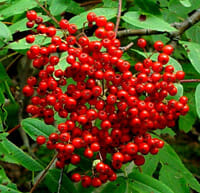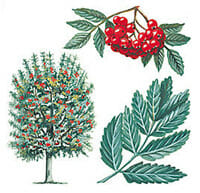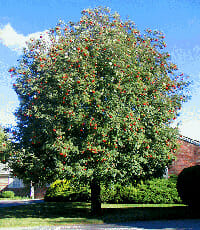Mountain Ash – Rosales Rosaceae Pyrus acuparia
 |
 |
 |
Identification & Description:
A decidious tree growing to 15m by 7m at a medium rate. It is hardy to zone 2 and is not frost tender. It is in flower from May to June, and the seeds ripen from August to September. The flowers are hermaphrodite (have both male and female organs) and are pollinated by Insects. It is noted for attracting wildlife. We rate it 2 out of 5 for usefulness.
The plant prefers light (sandy), medium (loamy) and heavy (clay) soils, requires well-drained soil and can grow in heavy clay soil. The plant prefers acid, neutral and basic (alkaline) soils and can grow in very acid and very alkaline soils. It can grow in semi-shade (light woodland) or no shade. It requires moist soil. The plant can tolerate maritime exposure. It can tolerate atmospheric pollution.
Habitats and Possible Locations
Woodland, Canopy.
Cultivar ‘Beissneri’: Woodland, Canopy.
Cultivar ‘Edulis’: Woodland, Canopy.
Cultivar ‘Rossica Major’: Woodland, Canopy.
Edible Uses
Coffee; Fruit; Leaves; Tea.
Fruit – raw or cooked. The fruit is very acid and large quantities of the raw fruit can cause stomach upsets. It can be used to make delicious, if slightly acidulous, jams and preserves, the fruit can also be dried and used as a flour mixed with cereals. The fruit is about 7.5mm in diameter and is produced in quite large bunches making harvest easy.
The leaves and flowers are used as a tea substitute.
Young leaves are said to be a famine food but they contain a cyanogenic glycoside so you should be very hungry before even thinking of eating them.
A coffee substitute. The report was referring to the fruit, it probably means the roasted seed.
The Mountain Ash (Pyrus Aucuparia, Gaertn.) is not related to the true Ashes, but has derived its name from the similarity of the leaves.
In comparison to the true Ash, it is but a small tree, rarely more than 30 feet high. It belongs to the order Rosacece and is distinguished from its immediate relations the Pear, Crab Apple, White Beam and Wild Service Tree by its regularly pinnate, Ashlike leaves. It is generally distributed over the country in its wild state, but is also much cultivated as an ornamental tree.
All parts of the tree are astringent and may be used in tanning and dyeing black. When cut, the Mountain Ash yields poles and hoops for barrels.
Both the bark and fruit have medicinal properties.
The fruit is rather globose, with teeth at the apex and two to three seeded cells. They are used medicinally in either the fresh or the dried state.
Constituents
The fruit contains tartaric acid before, citric and malic acids after ripening; two sugars, sorbin and sorbit, the latter after fermentation; parasorbic acid, which is aromatic and is converted into isomeric sorbic acid by heating under pressure with potassa; bitter, acrid and colouring matters. A crystalline saccharine principle, Sorbitol, which does not undergo the vinous fermentation, has also been found in the fruit.
The seeds contain 22 per cent. of fixed oil. It has been claimed that these seeds killed a child, apparently by prussic acid poisoning.
The bark has a soft, spongy, yellowishgrey outer layer and an inner thicker portion, with many layers of a light brown colour. It has a bitterish taste, but is odourless.
It is astringent and also yields amygdalin.